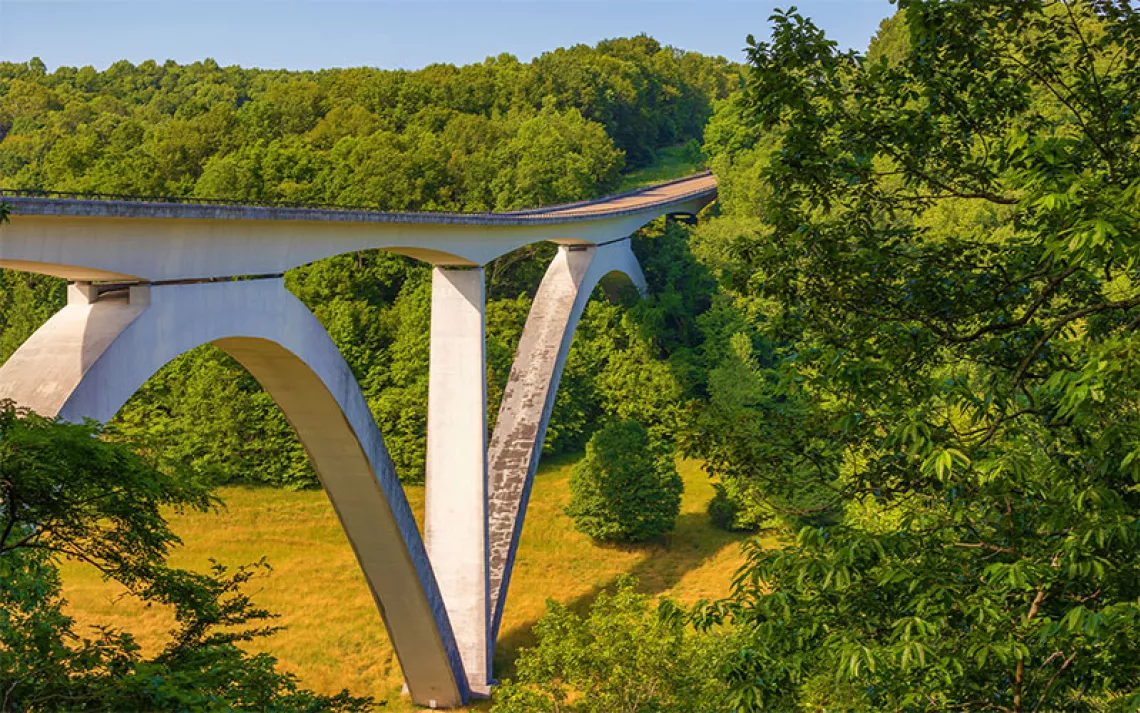Himalaya Bound
Michael Benanav chronicles the migration of the nomadic Van Gujjars
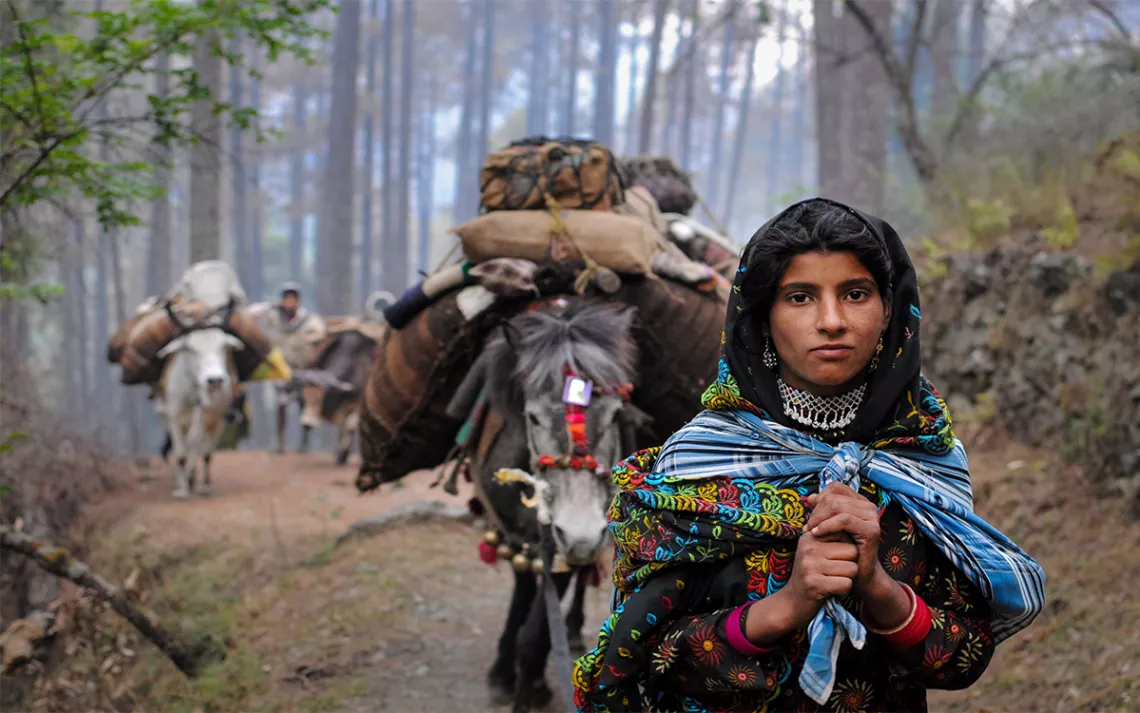
Seventeen-year-old Mariam leads her family’s caravan through the foothills of the Himalayas while carrying her two-year-old niece in a shawl. | All photos courtesy of Michael Benanav
For centuries, the Van Gujjars, a forest-dwelling nomadic tribe in northern India, have migrated into the Himalayas every spring with their beloved water buffalo. Now their culture and livelihood is at risk as some of the jungles and meadows they call home have become national parks. As he recounts in his new book, Himalaya Bound: One Family’s Quest to Save Their Animals—And an Ancient Way of Life, author and photographer Michael Benanav traveled with the Van Gujjars for 44 days, during which park officials threatened to block the families from their ancestral summer pastures. Himalaya Bound offers an intimate glimpse into a rarely seen world and raises important questions about the relationship between humankind and wildlands: Can humans be a natural part of ecosystems, or are they simply invasive species? Does removing native people pull one thread of a natural tapestry, pulling others along in a dangerous chain reaction?
Excerpted from Himalaya Bound: One Family’s Quest to Save Their Animals—And an Ancient Way of Life by Michael Benanav. Published by Pegasus Books. © Michael Benanav. Reprinted with permission. All other rights reserved.
*
Swirling gray clouds swallowed the mountaintops. A cold rain fell in surges, hard and heavy one minute, a light patter the next. Pearls of water dripped through holes in the ceiling of our tent, onto the aromatic bed of green pine needles that had been spread on the ground beneath it. The campfire burning nearby sputtered and smoldered, producing more smoke than flame.
Early that morning the skies had been clear, raising our hopes that the bad weather that had besieged us had finally broken. If we were lucky, we’d be able to tackle the final leg of our journey the next day. With this in mind, after the buffaloes were milked, Jamila asked a few of us to shuttle some of the family’s belongings all the way up to the hut at Kanasar, then return. She felt that some of the bulls and horses were still too worn out to carry full loads up and over the three-thousand-foot pass that stood between us and the meadow we had to reach, and anything we could haul in advance would help.
Carrying as much as we could, Gamee, Appa, Sharafat and I followed the trail along the creek, through the tight, rocky canyon and out into the treeless bowl at the base of the pass. As we began to ascend the lower section of the bowl, which was like a ramp that became steeper and steeper, the sky darkened. We lost sight of the highest ridge, and watched as ash-colored clouds slid down the rim and into the basin. As much as we wanted to press onward, the risks of being caught in a Himalayan storm while exposed on a bare mountainside had potential consequences too grim to ignore. We cached what we were carrying among some bushes, intending to pick them up when we trekked by them the following day, and hustled back to camp through a thickening mist, arriving just as the deluge began.
After a two-chapati lunch, nearly everyone went out to watch the herds. Huddling together under umbrellas or beneath trees, they tried, unsuccessfully, to stay dry. Their plastic shoes filled with water; their woolen shawls were soaked. But they endured the storm with stoicism and mostly good humor, their own comfort less important than keeping their animals away from the deadly rhododendron.
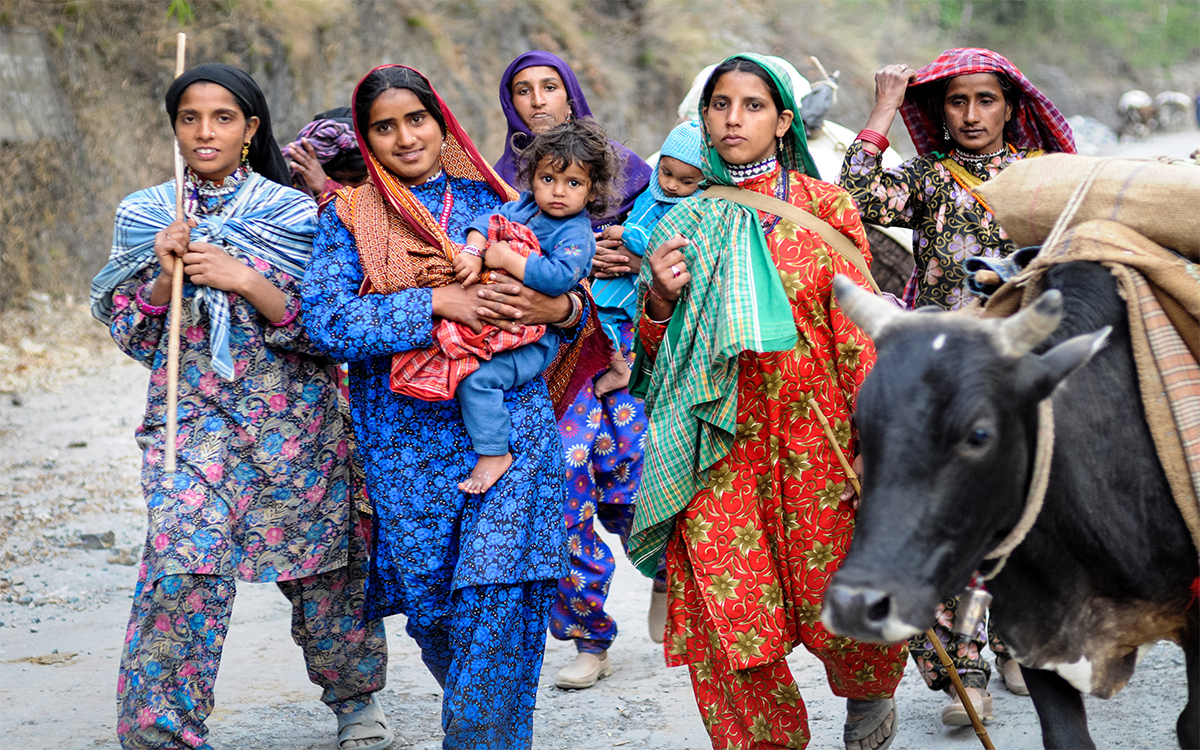
Above: Though they are Muslim, Van Gujjar women never veil their faces—except on their wedding day.
Below: Sharafat dries off after a swim in the Yamuna River.
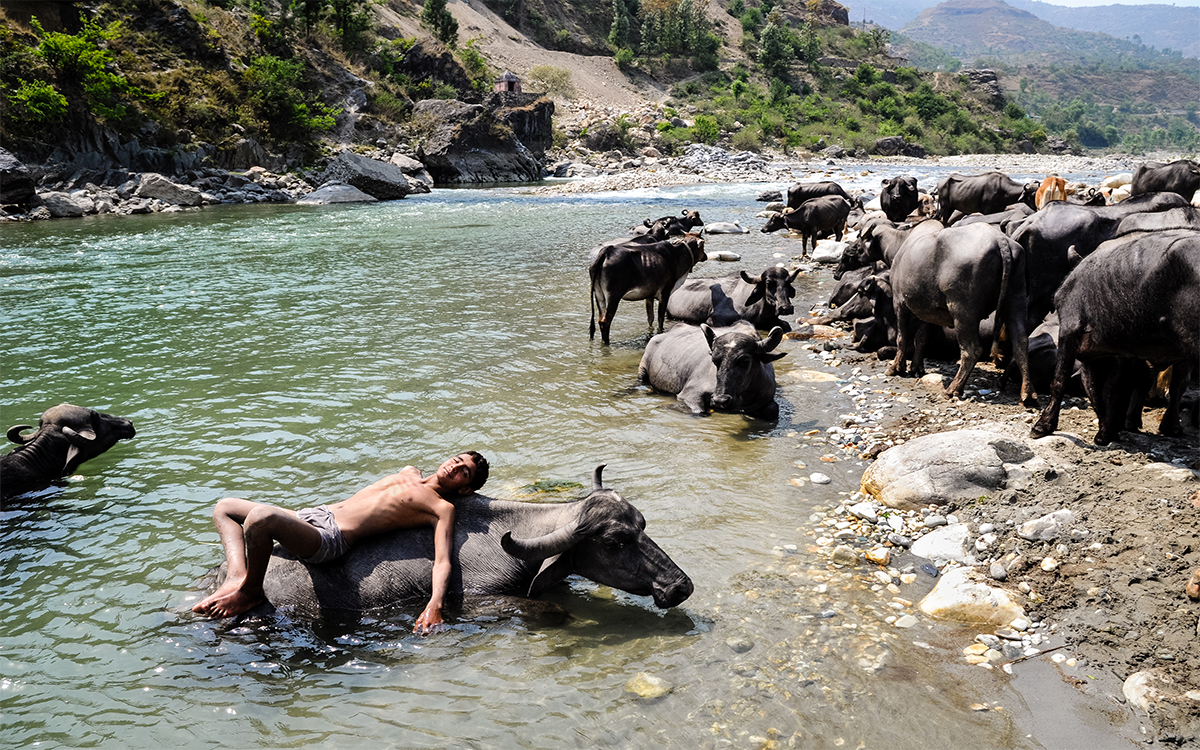
Not feeling any particular need to get drenched myself, I stayed under the tent, catching up on some writing and talking to the women who were watching over the youngest children. Akloo, whose sculpted cheeks were loosely framed by a green-and-purple headscarf, cradled little Hasina. Appa, in a yellow polyester sweater over a green kameez, brushed out Salma’s hair. Mariam was lying down, wrapped in a brown fleece blanket, resting but awake enough to giggle and joke with the rest of us. It was a moment as sweet as it was mundane..
Our relaxed banter was abruptly severed by a scream. It sounded so panicked, so distressed, I instantly thought, “Who’s dead?” Appa and Mariam turned to each other with fear in their faces and simultaneously said, “Bashi!” Leaping up without bothering to put on their shoes, they dashed towards the source of the shriek. I grabbed my camera, slipped on my raincoat and shoes, and followed, while Akloo stayed under the tent with the children.
Up the canyon we ran, along the muddy trail, leaping from rock to rock to cross the churning creek, and sometimes wading through it. The sound of the rushing water was amplified by the walls of the gorge into a wild roar, heightening the sense of emergency as we raced toward the unknown disaster. After about two minutes, we met Bashi, who was sprinting towards us in tears. She could barely speak through her sobs, her whole body shaking as she tried to explain what happened. As soon as Appa and Mariam got the picture, they bolted on up the trail and I went with them, while Bashi continued running down to camp.
Bashi had been tending to the calves, as she usually did. They’d been led up the trail from the camp, to a flat bank just above the creek in the gorge that funneled runoff down from the highest ridges. Hiding from the weather, the animals clustered together at the base of a sheer cliff, instinctually seeking cover under a rock overhang, though not all of them could fit beneath it. Bashi huddled in close with the calves, knowing her presence helped calm them—and taking comfort from them as well. When the downpour temporarily tapered off, she came out from under the alcove, scrambled down the side of the bank, and crossed the creek to fetch a bundle of grass for her four-legged friends to munch on.
Suddenly, the storm burst back to life. Thunder shook the canyon. Rain exploded from the sky. At the top of the rock wall, some seventy feet directly above the young buffaloes, a flash flood became a waterfall when it poured over the precipice. In its path was a dead tree, which the surging waters lifted up and flung over the cliff’s edge. Just before it struck the ground, the tree smashed into five of the buffalo calves.
Bashi saw the whole thing, and screamed with every ounce of her being. She was lucky that she’d been on the other side of the creek when the tree fell, but that didn’t cross her mind. She thought only of the calves. She was terrified that they would die. She turned and ran for the tents, her bare feet splashing through frigid puddles while she cried hysterically, yelling for help. Her brothers, sisters, and cousins were already on their way.
Within minutes, eight of us had reached the site of the accident. By then, the rain had paused again. My friends surveyed the scene, taking in the size of the tree that lay splayed on the ground, then looking up to the top of the cliff and tracing its fall with their eyes. For a moment, they were frozen by disbelief, but this quickly thawed into a devastated grief for the wounded calves. Heartrending wails and sobs and shouts of protest were directed at the clouds. Their emotional response was so intense, so distressed, I couldn’t imagine how they would have reacted if Bashi herself had been struck. After a minute or two of chaos, Gamee—the oldest on the scene—took on the role of incident commander and organized his brothers, sisters, and cousins for action.
Though they were focused and efficient, everyone, even the men, wept as they triaged the animals, sorting the wounded from the well, checking the injured, and building a bonfire to keep the calves warm.
The five victims were large yearlings. Two were obviously okay, their tough black hide only scraped by the tree’s branches. Another two suffered blows to their bodies and seemed like they might have had internal injuries, but it was hard to tell how seriously they were hurt. The fifth was in the worst shape. Her front left leg had been crushed. A severed bone stuck out through her flesh; the hoof beneath it flopped around like it was held on by a rubber band.
Mariam warmed a burlap sack over the fire, then spread it over the back of the broken-legged yearling. Lying on the ground, she was too hurt to struggle as Gamee, Chamar, and Hamju tried to straighten her leg—which was bent at a troublingly unnatural angle—and covered the wound with a shirt and scarf. Blood dripped from the corner of the animal’s mouth. She sank into deep lethargy. I’m not sure if it’s possible, but it looked like tears were welling in the corners of her eyes. She seemed like she might be dying. And the rain started falling again.
I had been moved to the verge of tears myself, as much out of empathy for my distraught friends as for the injured creature. Yet, at the same time, the photojournalist in me couldn’t help but recognize that I’d been thrust into a scenario the likes of which few people had ever seen, let alone photographed. I imagined the shots I could get of nomads in a Himalayan storm, weeping over their animals as they tried to care for them. My camera felt like it was jumping up and down beneath my rain jacket, begging to be taken out and used. But I couldn’t bring myself to do it.
The moment was so personal, so raw, I felt that taking pictures of their grief would have been intrusive and inappropriate, that their intensely emotional reaction to this sudden tragedy deserved the dignity of privacy. I imagined that a clicking camera would have introduced an element of self-consciousness at a time when my friends most needed to be themselves, without concern for how they might appear to others; and I knew that if I was in their position, I would probably not want someone snapping pictures of my moment of distress. Respecting their feelings meant more to me than any photos I might have returned with. So, resisting the temptation to shoot, I kept my camera sheathed and instead did the only useful thing I could: I sat beside the buffalo with the broken leg and gently stroked her head, trying to give her some comfort.
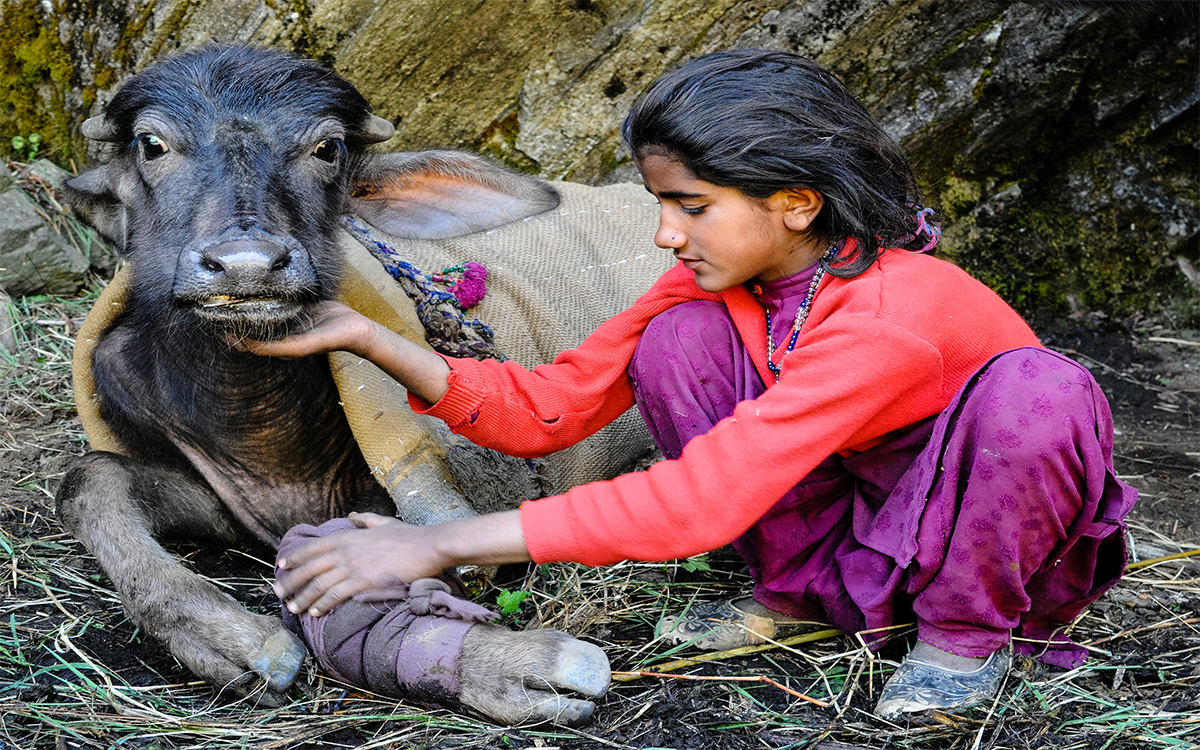
Bashi, 12, comforts a buffalo yearling with an injured leg.
After about fifteen minutes, Yusuf arrived. His pointy orange beard leapt in the wind as he asked what had happened, his tone at once demanding and desperate. While listening to the story, he dropped his umbrella, knelt on the soggy ground, and examined the injured yearlings, all of which belonged to him. Upon seeing the broken leg, he slapped his hands to his forehead. Facing skyward, he ranted in anguish, uttering short, tormented outbursts, each of which ended with a pained howl seared by despair.
A few moments later, Jamila and Roshni appeared. With calm confidence, the two women took control of the situation. They ushered their children away, sending them back to camp or to the herds of adult buffaloes temporarily left unattended. I stayed to see what they were going to do.
With their silver bracelets jingling, they mixed milk and turmeric powder together in a stainless steel jug and then, through a green plastic tube, poured the concoction down the throats of the three wounded yearlings to fortify them and deter infection. Jamila stoked the fire while Roshni re-warmed the burlap sack that was draped over the broken-legged buffalo’s back.
Suddenly, a barrage of thunder detonated with such force that it seemed to crack the sky. Hail began to fall, violently, in balls the size of cherries. Jamila, Roshni and I ran for shelter under the rock overhang. With their scarf-covered heads tilted to the heavens, the women watched with troubled eyes as millions of ice pellets streaked through the foggy air, beating a staccato drumroll that echoed off the canyon walls. Fate, they concluded, had truly turned against them, and they keened in high-pitched tones, plaintively praying to Allah with their whole souls, pleading for mercy while accepting whatever His hand would write for them.
Of course the passion with which Jamila and Roshni prayed was fueled by more than just the accident; their fervent chants and wails seemed like expressions of all of the frustrations and difficulties they had faced throughout the migration. Perhaps worst of all wasn’t even what they had endured, but what they had come to fear about the future—which was, in the simplest terms, that they had no future. They felt like the people in the songs Van Gujjars sing, forsaken by God in a cruel world that had no place for them.
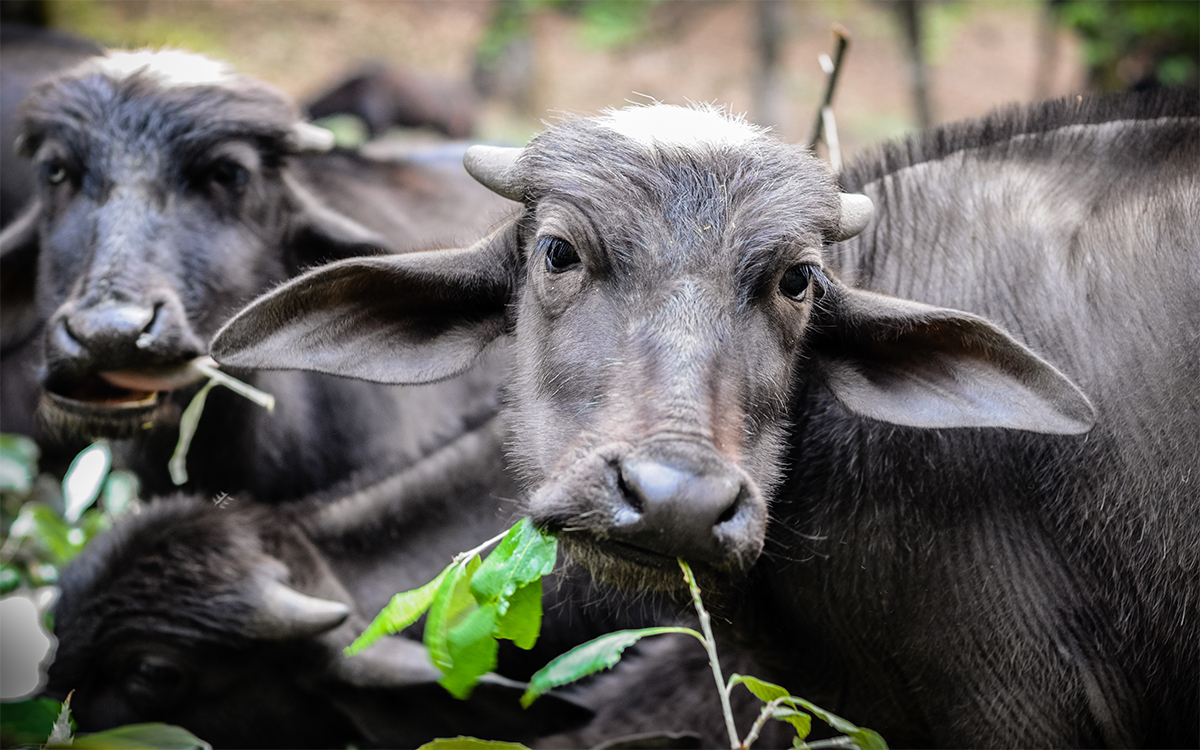
Above: A water buffalo calf munches on leaves. The Van Gujjars never eat their buffaloes nor sell them for slaughter. When one dies, the tribe will bury and mourn it as a family member.
Below: Dhumman with his herd along the Asan River.
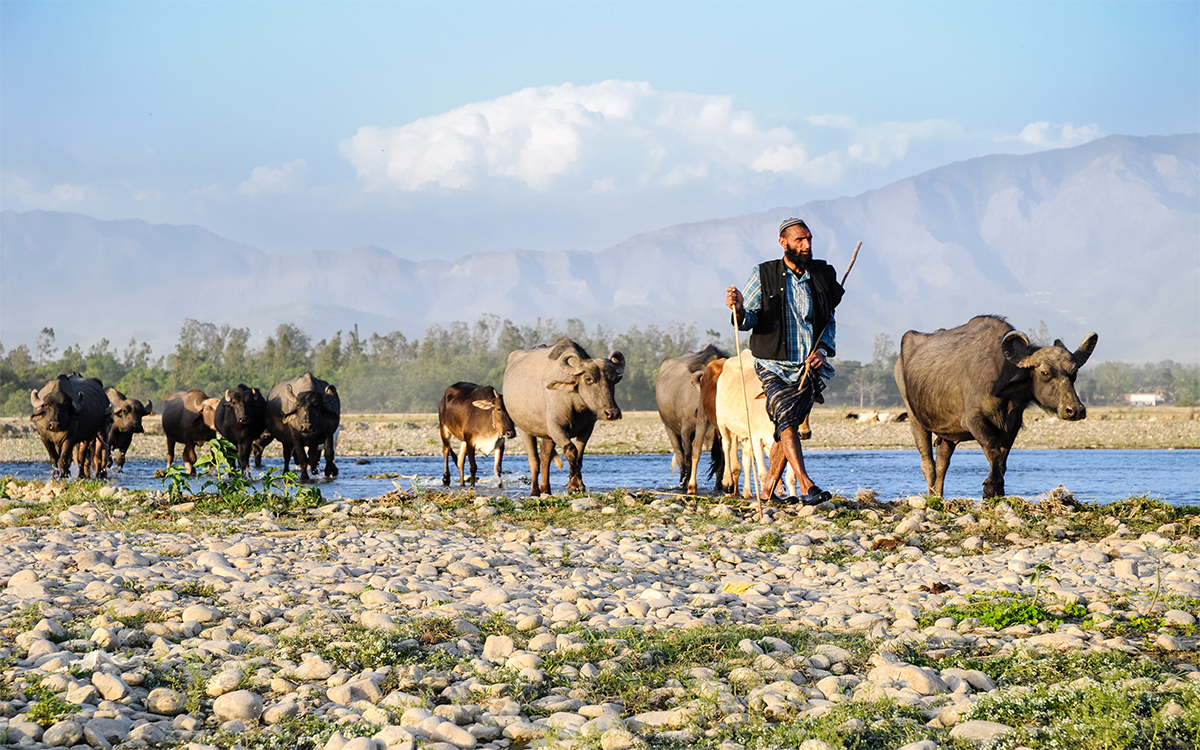
That evening, Hamju and Sharafat returned to the calves with blankets and food for themselves. They would spend the night there. They concluded that the two buffaloes suspected of having internal injuries only had some bruises and would be fine. But things looked bad for the yearling with the broken leg. With an open compound fracture, I didn’t see how she could survive. The only question in my mind was whether she’d be left behind to die or would be humanely euthanized, somehow.
I expected there’d be a funereal feeling in the air around camp that evening, but there wasn’t. The storm was still sitting on top of us, pounding us intermittently. Between keeping an eye on the buffaloes and keeping the fires going, people were too preoccupied to wallow in emotion. Bashi had been so upset by what she’d seen and felt so guilty that it had happened on her watch, even though it clearly wasn’t her fault, I had wondered how long it would take her to get over it. But by dinnertime she was clearly feeling better, the comfort given by her family quickly—if not completely—repairing her world.
Dhumman returned after dark from his mission to Uttarkashi, carrying rolls of plastic, rope, and other miscellaneous supplies. Exhausted, he sat silently and ate the chapattis that were reheated for him on the fire, while listening to the story of the accident. Finishing his chai, he quietly asked a few questions. Then he went to see Yusuf.
Sitting by the fire at Yusuf’s tent, the two brothers talked for a long time. By the end of the conversation, they’d reached a decision about the yearling with the broken leg.
They were going to try to save her.
 The Magazine of The Sierra Club
The Magazine of The Sierra Club



